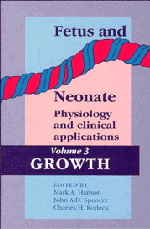Book contents
- Frontmatter
- Contents
- Preface to the series
- List of contributors
- Part I Physiology
- Part II Pathophysiology
- 6 Experimental restriction of fetal growth
- 7 Placental changes in fetal growth retardation
- 8 Human fetal blood gases, glucose, lactate and amino acids in IUGR
- 9 Glucose and fetal growth derangement
- 10 Fetal programming of human disease
- Part III Clinical applications
- Index
10 - Fetal programming of human disease
from Part II - Pathophysiology
Published online by Cambridge University Press: 04 August 2010
- Frontmatter
- Contents
- Preface to the series
- List of contributors
- Part I Physiology
- Part II Pathophysiology
- 6 Experimental restriction of fetal growth
- 7 Placental changes in fetal growth retardation
- 8 Human fetal blood gases, glucose, lactate and amino acids in IUGR
- 9 Glucose and fetal growth derangement
- 10 Fetal programming of human disease
- Part III Clinical applications
- Index
Summary
Introduction
Babies who are small at birth and during infancy are now known to be at increased risk of developing coronary heart disease, hypertension and diabetes during adult life. It is thought that these diseases are ‘programmed’ by an inadequate supply of nutrients or oxygen in utero or immediately after birth. The term ‘programming’ describes the process whereby a stimulus or insult at a critical period of development has lasting or lifelong significance (Lucas, 1991). The principle that the nutritional, hormonal, and metabolic environment afforded by the mother may permanently ‘program’ the structure and physiology of her offspring has long been established. Recent findings suggest that it is important in the development of human disease.
This chapter has three sections.
A summary of the phenomenon of programming.
A discussion of the ways in which maternal undernutrition may influence fetal growth and metabolism.
A review of the links between fetal undernutrition and adult disease in man.
Principles and mechanisms of programming
Animal studies have established three principles which appear to underlie the phenomenon of programming and point to several mechanisms which may mediate its effects. These are discussed in turn.
Permanent effects of early adverse influences
The primary concept of programming is that adverse influences acting early in life have permanent effects on the body's structure and physiology. One of the best examples of programming is the effect of early exposure to sex hormones on the development of sexual physiology and behaviour.
- Type
- Chapter
- Information
- Fetus and Neonate: Physiology and Clinical Applications , pp. 255 - 274Publisher: Cambridge University PressPrint publication year: 1995
- 4
- Cited by



